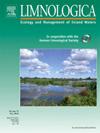Hydrochemistry, microbial ecology and physiological-biochemical properties of isolated bacteria of Tyrma hot spring (Far East of Russia)
IF 2
4区 环境科学与生态学
Q2 LIMNOLOGY
引用次数: 0
Abstract
In this study, we investigated for the first time the geochemistry, abundance, diversity and some physiological and biochemical properties of cultured bacterial communities inhabiting the Tyrminskie thermal springs (Far East, Russia). The thermal waters from the Tyrma Spring are characterized by a low mineralization level (less than 0.25 g/L), an alkaline pH medium (pH=9.4) and a fluoride (up to 10 mg/L) and bicarbonate sodium-based composition. In these thermal waters and associated microbial mats, low numbers of physiological groups of microorganisms were noted, with a predominance of heterotrophically active nitrifying bacteria in the water and silicate- and sulfate-reducing bacteria in the mats. The average air temperature during the winter was −7°C. The temperature of the spring water during sampling was recorded between 31.8 and 36.8°C. These temperatures favor the presence of mesophilic and thermotolerant microorganisms in the thermal waters, which is consistent with the identified bacterial genera. Bacterial strains isolated from the thermal waters were identified using the 16S rRNA gene. The isolated bacterial strains belong to the phyla Firmicutes, Proteobacteria and Actinobacteria. Bacterial strains of thermal waters were represented by the genera Bacillus, Ochrobactrum, Brevibacterium, Achromobacter. Shannon and Simpson ecological indices showed low bacterial diversity and their uniform distribution in the community. It should be noted that this assay is based solely on cultured microorganisms using standard culture media. According to canonical correspondence analysis the greatest influence on bacterial diversity was exerted by the elements: calcium, sodium, fluorine, and hydrocarbonates. The isolated bacteria were able to metabolize a wide range of carbohydrates and alcohols, although they fermented lactose poorly. Cultures of the Bacillus genus show the greatest sugar-metabolizing activity. The isolates are capable of producing extracellular enzymes, indicating their potential industrial applications.
俄罗斯远东Tyrma温泉分离菌的水化学、微生物生态学及生理生化特性
本文首次对俄罗斯远东地区Tyrminskie温泉中培养细菌群落的地球化学特征、丰度、多样性及一些生理生化特性进行了研究。Tyrma温泉热水的特点是矿化水平低(小于0.25 g/L), pH值为碱性(pH=9.4),氟化物(高达10 mg/L)和碳酸氢盐钠基成分。在这些热水和相关的微生物垫中,注意到生理微生物群数量较少,水中的异养活性硝化细菌和垫中的硅酸盐和硫酸盐还原细菌占主导地位。冬季平均气温为- 7°C。采样时的泉水温度在31.8 ~ 36.8℃之间。这些温度有利于热水体中嗜温和耐热微生物的存在,这与已鉴定的细菌属一致。利用16S rRNA基因对从温泉水中分离的菌株进行鉴定。分离到的菌株分别属于厚壁菌门、变形菌门和放线菌门。温泉水细菌菌株主要有芽孢杆菌属、赭杆菌属、短杆菌属、无色杆菌属。Shannon和Simpson生态指数显示群落细菌多样性较低且分布均匀。应该注意的是,该试验仅基于使用标准培养基培养的微生物。根据标准对应分析,对细菌多样性影响最大的是元素:钙、钠、氟和碳酸盐。分离出来的细菌能够代谢大量的碳水化合物和酒精,尽管它们发酵乳糖的能力很差。芽孢杆菌属的培养物表现出最大的糖代谢活性。分离物能够产生胞外酶,表明其潜在的工业应用前景。
本文章由计算机程序翻译,如有差异,请以英文原文为准。
求助全文
约1分钟内获得全文
求助全文
来源期刊

Limnologica
环境科学-湖沼学
CiteScore
3.70
自引率
5.90%
发文量
64
审稿时长
3 months
期刊介绍:
Limnologica is a primary journal for limnologists, aquatic ecologists, freshwater biologists, restoration ecologists and ecotoxicologists working with freshwater habitats.
 求助内容:
求助内容: 应助结果提醒方式:
应助结果提醒方式:


